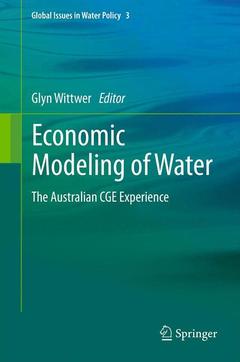Description
Economic Modeling of Water, 2012
The Australian CGE Experience
Global Issues in Water Policy Series, Vol. 3
Coordinator: Wittwer Glyn
Language: English
Subjects for Economic Modeling of Water:
Economic Modeling of Water. The Australian CGE Experience
Publication date: 04-2014
188 p. · 15.5x23.5 cm · Paperback
Publication date: 04-2014
188 p. · 15.5x23.5 cm · Paperback
Economic modeling of water
Publication date: 03-2012
188 p. · 15.5x23.5 cm · Paperback
Publication date: 03-2012
188 p. · 15.5x23.5 cm · Paperback
Description
/li>Contents
/li>Comment
/li>
The book details the innovative TERM (The Enormous Regional Model) approach to regional and national economic modeling, and explains the conversion from a comparative-static to a dynamic model. It moves on to an adaptation of TERM to water policy, including the additional theoretical and database requirements of the dynamic TERM-H2O model. In particular, it examines the contrasting economic impacts of water buyback policy and recurring droughts in the Murray-Darling Basin. South-east Queensland, where climate uncertainty has been borne out by record-breaking drought and the worst floods in living memory, provides a chapter-length case study. The exploration of the policy background and implications of TERM?s dynamic modeling will provide food for thought in policy making circles worldwide, where there is a pressing need for solutions to similarly intractable problems in water management.
Foreword.- Preface.- 1. Practical Policy Analysis Using TERM.- PART I: The TERM Approach.- 2. The TERM Model and its Data Base.- 3. Introducing Dynamics to TERM.- PART II: Water Modeling.- 4. Water Resources Modeling: A Review.- 5. The Theory of TERM-H2O.- 6. Buybacks to Restore the Southern Murray-Darling Basin.- 7. The Economic Consequences of a Prolonged Drought in the Southern Murray-Darling Basin.- 8. Urban Water Supply: A Case Study of South-east Queensland.- 9. Applying TERM-H2O to Other Countries.- Index.
Case studies explore internationally relevant policy implications Provides the full theoretical basis of a CGE model with water accounts that distinguish between dry-land and irrigation agriculture Combines localised regional analysis with broader national implications Includes detailed structural analysis as a starting point for explaining modeled outcomes
© 2024 LAVOISIER S.A.S.




